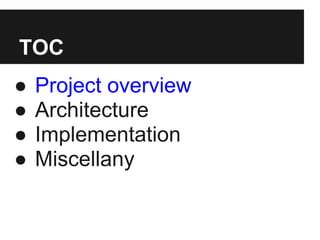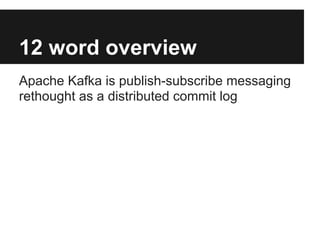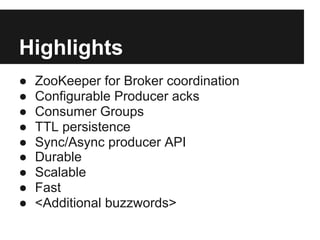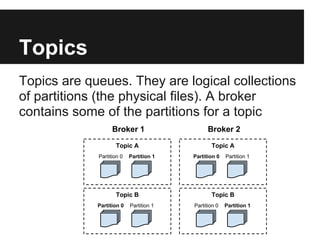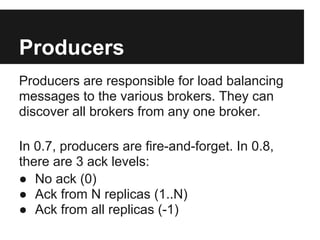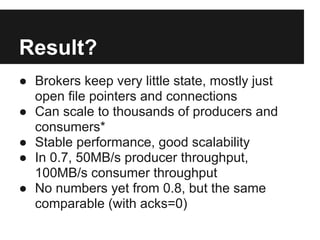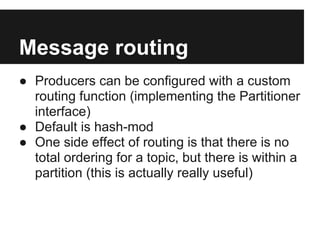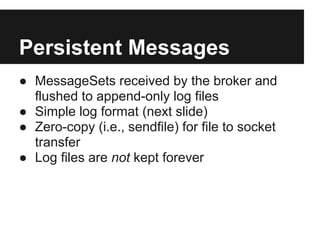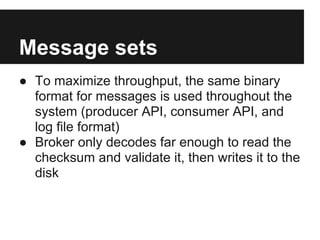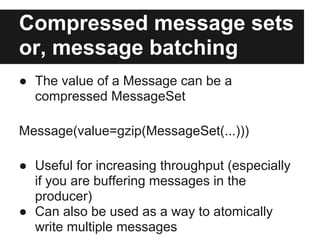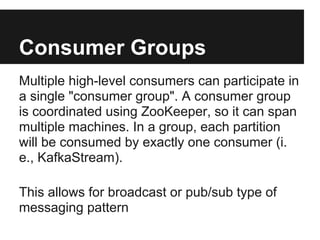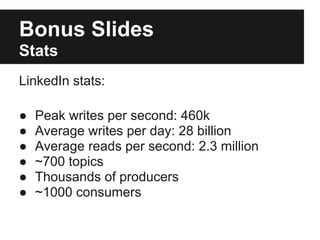Introduction and Overview of Apache Kafka, TriHUG July 23, 2013
- 1. Apache Kafka //TODO Insert Logo
- 2. About Me David Arthur http://mumrah.github.io/ ● Software Engineer at LucidWorks ● Open source contributor ● Gardener ● Dad
- 3. TOC ● Project overview ● Architecture ● Implementation ● Miscellany
- 4. Project info ● http://kafka.apache.org ● Written in Scala ● Open sourced by LinkedIn SNA in 2011 ● Soon after entered Apache Incubator ● Not just an idle "open source donation" ● Active development, 0.8 out now ● Apache TLP late 2012, 13 committers ● Still no logo
- 5. 12 word overview Apache Kafka is publish-subscribe messaging rethought as a distributed commit log
- 6. Ok... Kafka is a persistent, distributed, replicated pub/sub messaging system. Publishers send messages to a cluster of brokers. The brokers persist the messages to disk. Consumers then request a range of messages using an (offset, length) style API. Use of NIO FileChannel allows for very fast transfer of data in and out of the system.
- 7. Highlights ● ZooKeeper for Broker coordination ● Configurable Producer acks ● Consumer Groups ● TTL persistence ● Sync/Async producer API ● Durable ● Scalable ● Fast ● <Additional buzzwords>
- 8. Motivation ● Activity stream processing (user interactions) ● Batch latency was too high ● Existing queues handle large volumes of (unconsumed) data poorly - durability is expensive ● Need something fast and durable
- 9. Key design choices ● Pub/sub messaging pattern ● Messages are persistent ● Everything is distributed - producers, brokers, consumers, the queue itself ● Consumers maintain their own state (i.e., "dumb" brokers) ● Throughput is key
- 10. TOC ● Project overview ● Architecture ● Implementation ● Miscellany
- 11. Brokers ● Receive messages from Producers (push), deliver messages to Consumers (pull) ● Responsible for persisting the messages for some time ● Relatively lightweight - mostly just handling TCP connections and keeping open file handles to the queue files
- 12. Log-based queue Messages are persisted to append-only log files by the broker. Producers are appending to these log files (sequential write), and consumers are reading a range of these files (sequential reads).
- 13. Log-based queue Message 0 Message 1 Message 2 Message 3 Producer Message 4 Message 5 Message 6 Consumer A read 0-4 Consumer Bread 1-3 Broker
- 14. Topics Topics are queues. They are logical collections of partitions (the physical files). A broker contains some of the partitions for a topic Partition 0 Partition 1 Topic A Partition 0 Partition 1 Topic B Broker 1 Partition 0 Partition 1 Topic A Partition 0 Partition 1 Topic B Broker 2
- 15. Replication Partitions of a topic are replicated. One broker is the "leader" of a partition. All writes and reads must go to the leader. Replicas exist for fault-tolerance, not scalability. When writing, messages can be synchronously written to N replicas (depending on the producer's ACKiness)
- 16. Producers Producers are responsible for load balancing messages to the various brokers. They can discover all brokers from any one broker. In 0.7, producers are fire-and-forget. In 0.8, there are 3 ack levels: ● No ack (0) ● Ack from N replicas (1..N) ● Ack from all replicas (-1)
- 17. Consumers Consumers request a range of messages from a Broker. They are responsible for their own state Default implementation uses ZooKeeper to manage state. In 0.8.1, Brokers will expose an API for offset management to remove direct communication between consumers and ZooKeeper (a good thing).
- 18. Result? ● Brokers keep very little state, mostly just open file pointers and connections ● Can scale to thousands of producers and consumers* ● Stable performance, good scalability ● In 0.7, 50MB/s producer throughput, 100MB/s consumer throughput ● No numbers yet from 0.8, but the same comparable (with acks=0)
- 19. TOC ● Project overview ● Architecture ● Implementation ● Miscellany
- 20. High-level producer API Producer#send(KeyedMessage<K,V> datum) KeyedMessage<K,V>(String topic, K key, V value) The Producer class determines where a message is sent based on the routing key. If a null key is given, the message is sent to a random partition
- 21. Message routing Partition 0 Partition 1 Topic A Broker 1 Partition 0 Partition 1 Topic A Broker 2 hash("foo") % 4 Partitioner Producer.send("A", "foo", messages) Producer
- 22. Message routing ● Producers can be configured with a custom routing function (implementing the Partitioner interface) ● Default is hash-mod ● One side effect of routing is that there is no total ordering for a topic, but there is within a partition (this is actually really useful)
- 23. (Partially) Ordered Messages Consider a system that is processing updates. If you partition the messages based on the primary key you guarantee all messages for a given key end up in the same partition. Since Kafka guarantees ordering of the messages at the partition level, your updates will be processed in the correct sequence.
- 24. Persistent Messages ● MessageSets received by the broker and flushed to append-only log files ● Simple log format (next slide) ● Zero-copy (i.e., sendfile) for file to socket transfer ● Log files are not kept forever
- 25. Log Format append Log file MessageSet MessageSet MessageSet MessageSet /tmp/kafka-logs/00000000000000000000.kafka append append appendBroker ByteBufferMessageSet#writeTo(FileChannel) Index 0: 0 1: 1024 2: 2048 Message offset index
- 26. Message sets ● To maximize throughput, the same binary format for messages is used throughout the system (producer API, consumer API, and log file format) ● Broker only decodes far enough to read the checksum and validate it, then writes it to the disk
- 27. Compressed message sets or, message batching ● The value of a Message can be a compressed MessageSet Message(value=gzip(MessageSet(...))) ● Useful for increasing throughput (especially if you are buffering messages in the producer) ● Can also be used as a way to atomically write multiple messages
- 28. Zero-copy Reading data out of Kafka is super fast thanks to java.nio.channels.FileChannel#transferTo. This method uses the "sendfile" system call which allows for very efficient transfer of data from a file to another file (including sockets). This optimization is what allows us to pull ~100MB/s out of a single broker
- 29. High-level Consumer API Map topicMap = Collections.singletonMap("topic", 2); Map<String,List<KafkaStream>> streams = Consumer.createJavaConsumerConnector(topicMap); ● KafkaStream is an iterable ● Blocking or non-blocking behavior ● Auto-commit offset, or manual commit ● Participate in a "consumer group"
- 30. Consumer Groups Multiple high-level consumers can participate in a single "consumer group". A consumer group is coordinated using ZooKeeper, so it can span multiple machines. In a group, each partition will be consumed by exactly one consumer (i. e., KafkaStream). This allows for broadcast or pub/sub type of messaging pattern
- 31. Consumer Groups P0 P1 Topic "foo" Broker 1 Consumer Group A Consumer Group B P2 P3 Topic "foo" Broker 2
- 32. TOC ● Project overview ● Architecture ● Implementation ● Miscellany
- 33. But, I already have a MQ Many people with distributed systems already have something like JMS, RabbitMQ, Kestrel, or ØMQ in place. These are all different systems with different implementation details and semantics. Decide what features you need, and then chose a MQ - not the other way around :) RabbitMQ discussion: http://bit.ly/140ZMOx
- 34. Caveats ● Not designed for large payloads. Decoding is done for a whole message (no streaming decoding). ● Rebalancing can screw things up if you're doing any aggregation in the consumer by the partition key ● Number of partitions cannot be easily changed (chose wisely) ● Lots of topics can hurt I/O performance
- 35. Clients ● Many exist, some more complete than others ● No official clients (other than Java/Scala) ● Community maintained ● Most lack support for high-level consumer due to ZooKeeper dependency (it's tricky) ● Excellent Python client: https://github. com/mumrah/kafka-python (yes, I wrote it) ● Only Python, C, and Clojure support the 0.8 protocol
- 36. Hadoop InputFormat ● InputFormat/OutputFormat implementations ● Uses low-level consumer, no offsets in ZK (they are stored on HDFS instead) ● Useful for long term storage of messages ● We use this! ● LinkedIn released Camus, a Kafka to HDFS pipeline
- 37. Integration A few good integration points. I expect more to show up as Kafka gains adoption ● log4j appender (in Kafka itself) ● storm-kafka (in storm-contrib) ● camel-kafka ● LogStash (loges) More listed on Kafka wiki http://bit.ly/1btZz8p
- 38. Applications Log Aggregation Many applications running on many machines. You want centralized logging, but don't want to install an agent (Flume, etc). Kafka includes a log4j appender <appender class="kafka.producer.KafkaLog4jAppender" name="kafka-solr"> <param name="zkConnect" value="localhost:2181"/> <param name="topic" value="solr-logs"/> <layout class="org.apache.log4j.PatternLayout"> <param value="%d{ISO8601} %p %c %m" name="ConversionPattern"/> </layout> </appender>
- 39. Applications Notifications Store data into data store A, need to sync it to data store B. Suppose you can send a message to Kafka when an update happens in A A Kafka Brecord X changed get updated record X
- 40. Applications Stream Processing Using a stream processing tool like Storm or Apache Camel, Kafka provides an excellent backbone. Data in Kafka topic A Process A Kafka topic B Process B
- 41. Bonus Slides Stats LinkedIn stats: ● Peak writes per second: 460k ● Average writes per day: 28 billion ● Average reads per second: 2.3 million ● ~700 topics ● Thousands of producers ● ~1000 consumers
- 42. Bonus Slides Logos! Being heatedly debated in JIRA as we speak!
- 43. Links! ● Slides: http://bit.ly/kafka-trihug ● Kafka Project: http://kafka.apache.org/ ● Kafka Code: https://github.com/apache/kafka ● LinkedIn Camus: https://github.com/linkedin/camus ● Zero-Copy IBM article: http://ibm.co/gsETNm ● LinkedIn Kafka paper: http://bit.ly/mC8TLS ● LinkedIn blog post on replication: http://linkd.in/YAWslH


